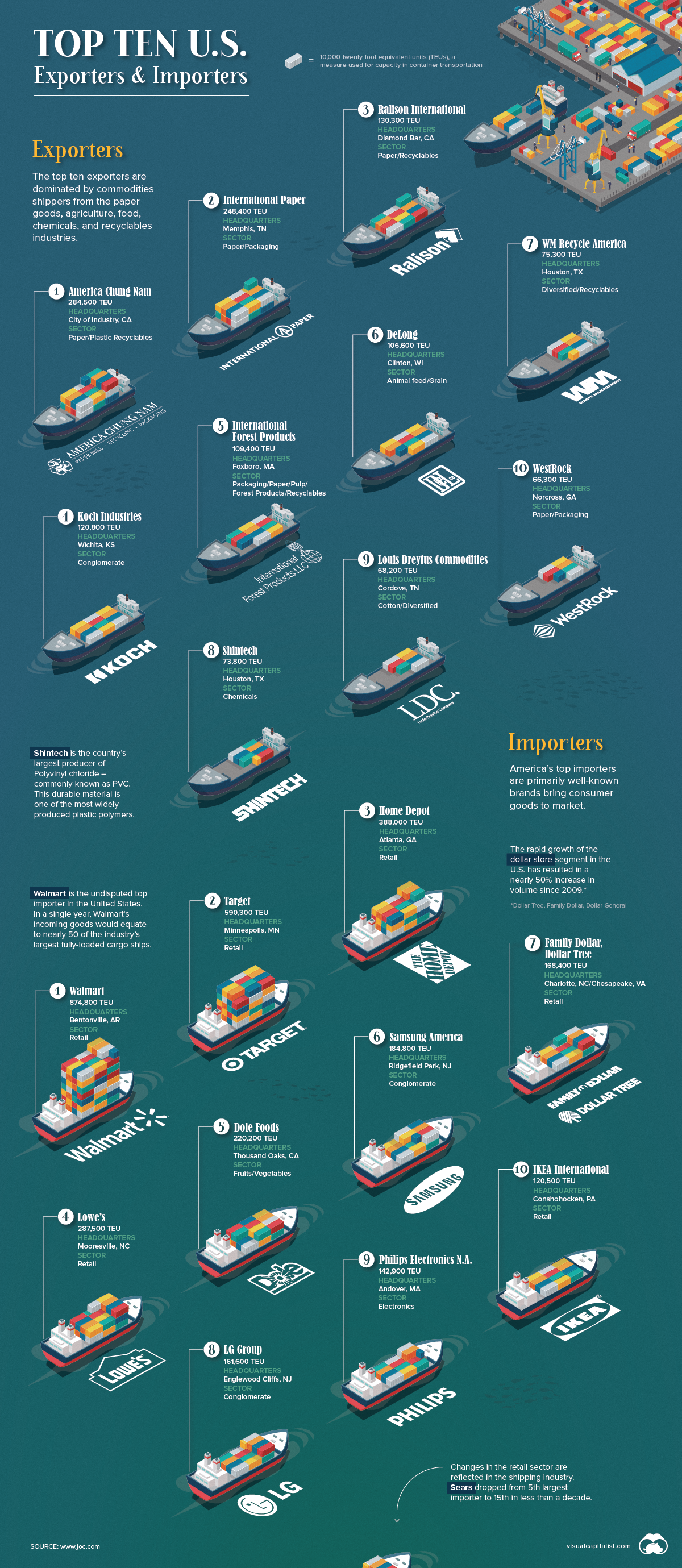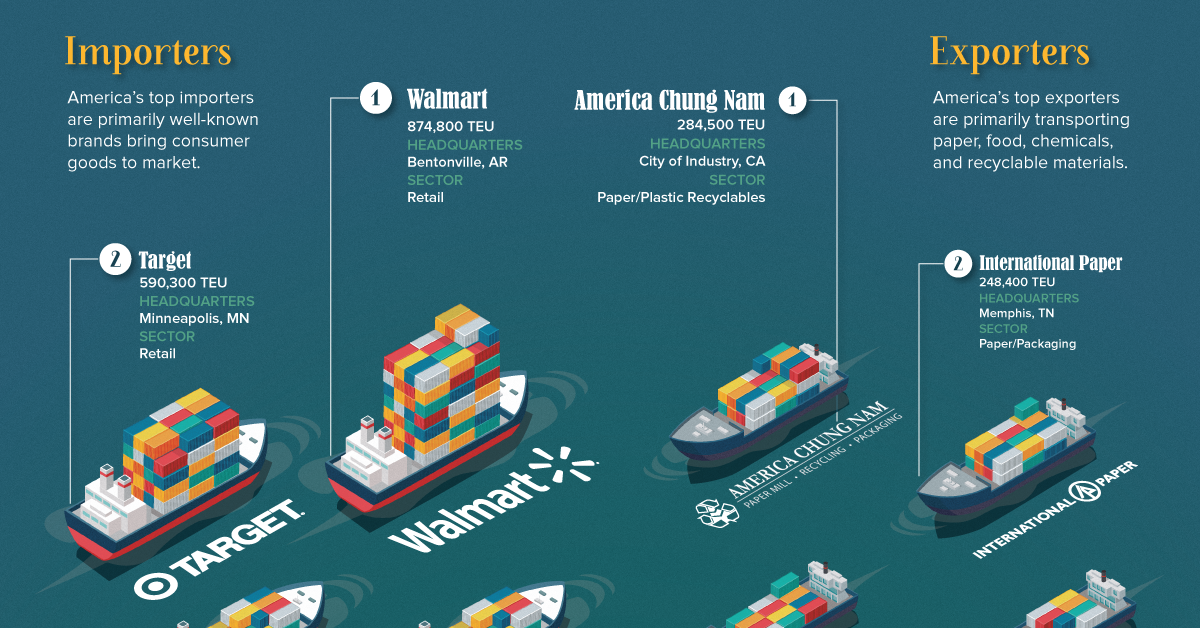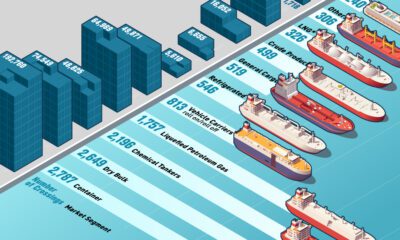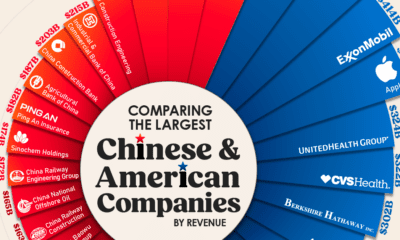Markets
Top U.S. Companies by Import and Export Volume

Nothing has transformed our economy quite like containerized shipping.
From Rotterdam to Singapore, we see tangible evidence of the world’s bustling maritime shipping network as cranes load and unload uniform containers in a flurry of activity. The efficiency of this system has massively impacted the global economy, but this uniformity has also had the unintended consequence of anonymizing shipping. From the outside looking in, there’s no indication of who’s actually doing the shipping.
Today’s graphic, using data from JOC, highlights the actual companies behind the United States’ import–export numbers.
Outgoing: Recyclables and Raw Materials
While companies like Procter & Gamble and Caterpillar export a high volume of consumer goods and equipment, the export market is dominated by bulk materials, natural resources, and chemicals.
Here are the top 20 companies by export volume (20-foot equivalent units, or TEUs):
| Rank | Company | TEU (2017) | Sector |
|---|---|---|---|
| 1 | America Chung Nam | 284,500 | 📄 Paper ♻️ Recyclables |
| 2 | International Paper | 248,400 | 📄 Paper 📦 Packaging |
| 3 | Ralison International | 130,100 | 📄 Paper ♻️ Recyclables |
| 4 | Koch Industries | 120,800 | 💼 Conglomerate |
| 5 | International Forest Products | 109,400 | 🌲 Paper/Forest Products ♻️ Recyclables |
| 6 | DeLong | 106,600 | 🐮 Animal Feed 🌾 Grain |
| 7 | WM Recycle America | 75,300 | 💼 Diversified ♻️ Recyclables |
| 8 | Shintech | 73,800 | 🛢 Chemicals |
| 9 | Louis Dreyfus Commodities | 68,200 | ⚪️ Cotton 💼 Diversified |
| 10 | WestRock | 66,300 | 📄 Paper 📦 Packaging |
| 11 | JBS USA | 65,400 | 🍖 Meats 🍗 Poultry |
| 12 | ExxonMobil Chemical | 63,400 | 🛢 Chemicals |
| 13 | Newport CH International | 62,100 | ♻️ Recyclables |
| 14 | BMW of North America | 61,600 | 🚘 Automotive Goods |
| 15 | Cargill | 57,500 | 💼 Conglomerate |
| 16 | JC Horizon | 55,600 | ♻️ Recyclables |
| 17 | Eastman Chemical | 53,800 | 🛢 Chemicals/Plastics |
| 18 | Potential Industries | 51,600 | 📄 Paper ♻️ Recyclables |
| 19 | Domtar | 48,100 | 🌲 Paper/Forest Products |
| 20 | Sims Metal Management | 47,700 | ⚙️ Metals ♻️ Recyclables |
Note: TEU = Twenty-foot equivalent unit, a measure of volume in units of twenty-foot long shipping containers.
Though exporters of recyclable materials feature prominently on this list, there may be a shake-up coming in the near future.
China’s Recycling Diet
In Western countries, people often assume that their top export by volume is a high-value manufactured good or, at very least, a natural resource like timber or oil. The truth is, a sizable portion of exports from Western countries are waste materials.
This isn’t a new trend. In 2009, nine of the top 20 exporters in the U.S. were sending recyclable materials overseas – particularly to China.
This convenient trade relationship, where ships bring consumer goods to America and return filled with recyclable materials, is being disrupted in a big way. In 2018, China launched Operation National Sword, which could potentially tie a knot in the steady pipeline of waste materials being imported into the country.
For now, countries like Vietnam and Thailand have picked up some of the slack, but before long, Western countries will need to take a serious look at beefing up domestic recycling programs.
Incoming: The Stuff We Buy
On the other end of the equation are the consumer goods that get purchased every day.
In modern society, there’s a very good chance the items around you right now were not built in the country you live in. While many companies import goods from overseas, a few major players move a staggering volume of goods through America’s ports.
Here are the top 20 companies by import volume (TEUs):
| Rank | Company | TEUs (2017) | Sector |
|---|---|---|---|
| 1 | Walmart | 874,800 | 🛒 Retail |
| 2 | Target | 590,300 | 🛒 Retail |
| 3 | Home Depot | 388,000 | 🛒 Retail |
| 4 | Lowe's | 287,500 | 🛒 Retail |
| 5 | Dole Food | 220,200 | 🍍 Produce |
| 6 | Samsung America | 184,800 | 💼 Conglomerate |
| 7 | Family Dollar / Dollar Tree | 168,400 | 🛒 Retail |
| 8 | LG Group | 161,600 | 💼 Conglomerate |
| 9 | Philips Electronics N.A. | 142,900 | 📺 Electronics |
| 10 | IKEA International | 120,500 | 🛒 Retail |
| 11 | Chiquita Brands Int'l | 117,500 | 🍌 Produce |
| 12 | Nike | 116,300 | 👞 Footwear / Apparel |
| 13 | Newell Brands | 115,400 | 🍶 Outdoor / Home Goods |
| 14 | Costco Wholesale | 111,700 | 🛒 Retail |
| 15 | Sears Holdings | 103,200 | 🛒 Retail |
| 16 | J.C. Penney | 101,100 | 🛒 Retail |
| 17 | General Electric | 92,300 | 💼 Conglomerate |
| 18 | Ashley Furniture Industries | 85,700 | 🛋 Furniture |
| 19 | Whirlpool | 74,700 | 🗄 Appliances |
| 20 | Heineken USA | 73,100 | 🍺 Beverages |
In contrast to the top exporters list, the top importing companies are generally more recognizable names, such as Target, Home Depot, Dollar Tree, and Ikea.
It will come as no surprise that Walmart, the world’s biggest retailer by some margin, is also America’s top importer. In a single year, Walmart’s incoming goods would equate to nearly 50 of the industry’s largest fully-loaded cargo ships.
Markets
The European Stock Market: Attractive Valuations Offer Opportunities
On average, the European stock market has valuations that are nearly 50% lower than U.S. valuations. But how can you access the market?

European Stock Market: Attractive Valuations Offer Opportunities
Europe is known for some established brands, from L’Oréal to Louis Vuitton. However, the European stock market offers additional opportunities that may be lesser known.
The above infographic, sponsored by STOXX, outlines why investors may want to consider European stocks.
Attractive Valuations
Compared to most North American and Asian markets, European stocks offer lower or comparable valuations.
| Index | Price-to-Earnings Ratio | Price-to-Book Ratio |
|---|---|---|
| EURO STOXX 50 | 14.9 | 2.2 |
| STOXX Europe 600 | 14.4 | 2 |
| U.S. | 25.9 | 4.7 |
| Canada | 16.1 | 1.8 |
| Japan | 15.4 | 1.6 |
| Asia Pacific ex. China | 17.1 | 1.8 |
Data as of February 29, 2024. See graphic for full index names. Ratios based on trailing 12 month financials. The price to earnings ratio excludes companies with negative earnings.
On average, European valuations are nearly 50% lower than U.S. valuations, potentially offering an affordable entry point for investors.
Research also shows that lower price ratios have historically led to higher long-term returns.
Market Movements Not Closely Connected
Over the last decade, the European stock market had low-to-moderate correlation with North American and Asian equities.
The below chart shows correlations from February 2014 to February 2024. A value closer to zero indicates low correlation, while a value of one would indicate that two regions are moving in perfect unison.
| EURO STOXX 50 | STOXX EUROPE 600 | U.S. | Canada | Japan | Asia Pacific ex. China |
|
|---|---|---|---|---|---|---|
| EURO STOXX 50 | 1.00 | 0.97 | 0.55 | 0.67 | 0.24 | 0.43 |
| STOXX EUROPE 600 | 1.00 | 0.56 | 0.71 | 0.28 | 0.48 | |
| U.S. | 1.00 | 0.73 | 0.12 | 0.25 | ||
| Canada | 1.00 | 0.22 | 0.40 | |||
| Japan | 1.00 | 0.88 | ||||
| Asia Pacific ex. China | 1.00 |
Data is based on daily USD returns.
European equities had relatively independent market movements from North American and Asian markets. One contributing factor could be the differing sector weights in each market. For instance, technology makes up a quarter of the U.S. market, but health care and industrials dominate the broader European market.
Ultimately, European equities can enhance portfolio diversification and have the potential to mitigate risk for investors.
Tracking the Market
For investors interested in European equities, STOXX offers a variety of flagship indices:
| Index | Description | Market Cap |
|---|---|---|
| STOXX Europe 600 | Pan-regional, broad market | €10.5T |
| STOXX Developed Europe | Pan-regional, broad-market | €9.9T |
| STOXX Europe 600 ESG-X | Pan-regional, broad market, sustainability focus | €9.7T |
| STOXX Europe 50 | Pan-regional, blue-chip | €5.1T |
| EURO STOXX 50 | Eurozone, blue-chip | €3.5T |
Data is as of February 29, 2024. Market cap is free float, which represents the shares that are readily available for public trading on stock exchanges.
The EURO STOXX 50 tracks the Eurozone’s biggest and most traded companies. It also underlies one of the world’s largest ranges of ETFs and mutual funds. As of November 2023, there were €27.3 billion in ETFs and €23.5B in mutual fund assets under management tracking the index.
“For the past 25 years, the EURO STOXX 50 has served as an accurate, reliable and tradable representation of the Eurozone equity market.”
— Axel Lomholt, General Manager at STOXX
Partnering with STOXX to Track the European Stock Market
Are you interested in European equities? STOXX can be a valuable partner:
- Comprehensive, liquid and investable ecosystem
- European heritage, global reach
- Highly sophisticated customization capabilities
- Open architecture approach to using data
- Close partnerships with clients
- Part of ISS STOXX and Deutsche Börse Group
With a full suite of indices, STOXX can help you benchmark against the European stock market.

Learn how STOXX’s European indices offer liquid and effective market access.

-

 Economy1 day ago
Economy1 day agoEconomic Growth Forecasts for G7 and BRICS Countries in 2024
The IMF has released its economic growth forecasts for 2024. How do the G7 and BRICS countries compare?
-

 Markets1 week ago
Markets1 week agoU.S. Debt Interest Payments Reach $1 Trillion
U.S. debt interest payments have surged past the $1 trillion dollar mark, amid high interest rates and an ever-expanding debt burden.
-

 United States1 week ago
United States1 week agoRanked: The Largest U.S. Corporations by Number of Employees
We visualized the top U.S. companies by employees, revealing the massive scale of retailers like Walmart, Target, and Home Depot.
-

 Markets2 weeks ago
Markets2 weeks agoThe Top 10 States by Real GDP Growth in 2023
This graphic shows the states with the highest real GDP growth rate in 2023, largely propelled by the oil and gas boom.
-

 Markets2 weeks ago
Markets2 weeks agoRanked: The World’s Top Flight Routes, by Revenue
In this graphic, we show the highest earning flight routes globally as air travel continued to rebound in 2023.
-

 Markets2 weeks ago
Markets2 weeks agoRanked: The Most Valuable Housing Markets in America
The U.S. residential real estate market is worth a staggering $47.5 trillion. Here are the most valuable housing markets in the country.
-

 Mining1 week ago
Mining1 week agoGold vs. S&P 500: Which Has Grown More Over Five Years?
-

 Markets2 weeks ago
Markets2 weeks agoRanked: The Most Valuable Housing Markets in America
-

 Money2 weeks ago
Money2 weeks agoWhich States Have the Highest Minimum Wage in America?
-

 AI2 weeks ago
AI2 weeks agoRanked: Semiconductor Companies by Industry Revenue Share
-

 Markets2 weeks ago
Markets2 weeks agoRanked: The World’s Top Flight Routes, by Revenue
-

 Demographics2 weeks ago
Demographics2 weeks agoPopulation Projections: The World’s 6 Largest Countries in 2075
-

 Markets2 weeks ago
Markets2 weeks agoThe Top 10 States by Real GDP Growth in 2023
-

 Demographics2 weeks ago
Demographics2 weeks agoThe Smallest Gender Wage Gaps in OECD Countries












